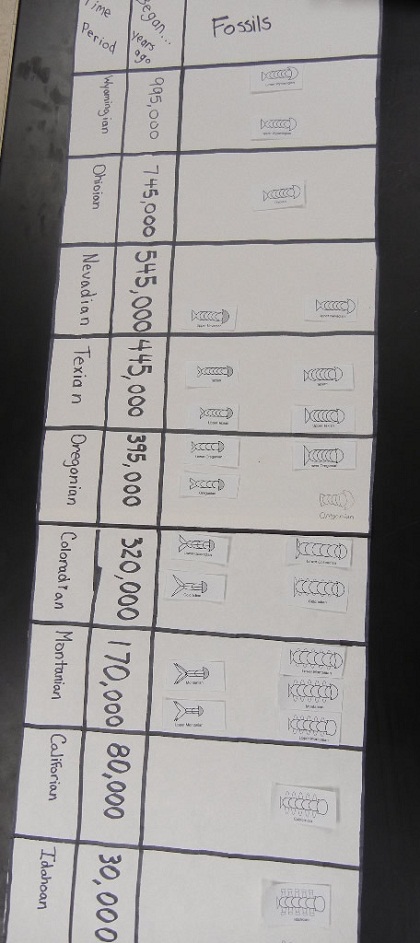Examining the Fossil Record Teacher's Guide
General Instructions and Tips
You may want to print out the .doc file, as it is formatted to print pages cleanly. websites often add things you don't need or break pages in inappropriate spots.
You can copy the webpage into an editor, such as word or openoffice and modify it for your classroom needs. If you repost, be sure to share alike, which is how the page is licensed. All of my worksheets can probably be improved upon, and definitely make changes if needed to fit with your own class and schedule.
This activity assumes students know the basic principles of evolution, it is more of an "end of the unit" activity than beginning.
You will need large poster paper to set up the record. I've used construction paper taped together if that's what I have laying around. Students like to pick colors too.
Analysis Questions - these are fairly open ended, I usually grade the project as a WHOLE, and not dwell on specific errors. This project is more about the "process" than the final outcome.
 Quick Rubric
Quick Rubric
1). Fossils Taped in (mostly) the correct order and shows a clear sequence of organisms as they change through time
__4 pts __3 pts __2 pts __1 pt
2) Analysis questions answered thoroughly, show depth and use specific examples to illustrate understanding of the topic
__4 pts __3 pts __2 pts __1 pt
3) Group worked well, shared responsibilities, cleaned area, etc
__2 pts __1 pt ( can deduct individuals for not sharing work)
Analysis Questions
1. Give a brief description of the evolutionary changes that occured in the organism. here, look for specific descriptors, as in how the organism changed from one time period to the next, focus on fins, segments, head, and legs.
2. During which time period did the fossils differentiate into two branches. this happened during the nevadian period.
3. Explain how the chart illustrates both punctuated equlibrium and gradualism. Use specific fossils from the chart to support your answer. punctuated equilibrium is shown in spots where the organism didn't change for a period of time, and then changed dramatically. Gradualism is illustrated by slow changes over time
4. Making the assumption that each fossil represents a separate species. Explain how the chart illustrates divergent and phyletic speciation.Use specific fossils from the chart to support your answer. divergent speciation is illustrated when the species split into two (nevadian), phyletic is illustrated as the two branches change over time.
5. Define the following terms:
- morphology - what it looks like
- fossil - remains of an organism
- phylogenetic tree - evoluationary history
6. Examine the fossil that was unearthered in a museum, apparently the labels and other information were lost. Using your fossil record, determine the time period this fossil is likely from. Montanian or californian
7. Of the two major species that arose from the parent species, which was more successful? How do you know? One species appeared to have become extinct prior to the californian era.
8. For each of the "blanks" on your fossil record make a sketch of what the animal would look like. Draw these right on your fossil record. - I usually tell the students to just pick one or two spots, it becomes tedious to fill in all of the spots.
Here is another photo of a completed project
